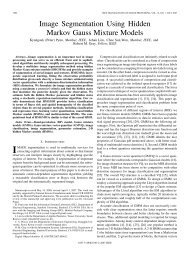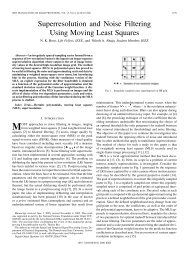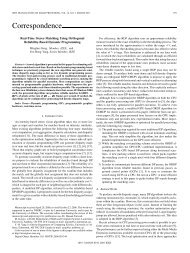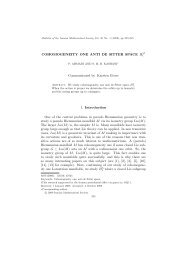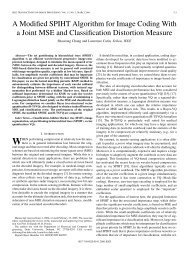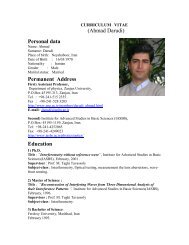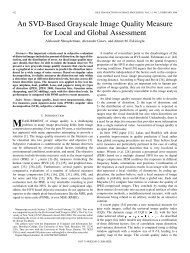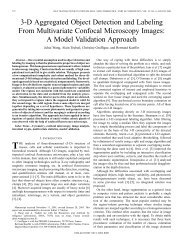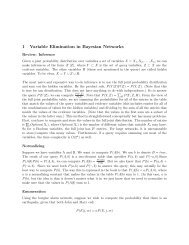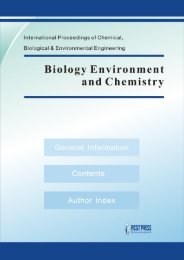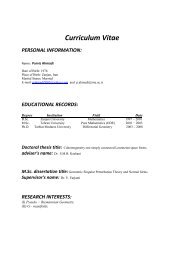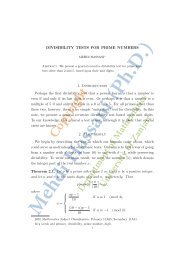Org. Chem. 1986,51, 2676
Org. Chem. 1986,51, 2676
Org. Chem. 1986,51, 2676
Create successful ePaper yourself
Turn your PDF publications into a flip-book with our unique Google optimized e-Paper software.
Distorted Amides as Models<br />
C-N-C(O)-C angle straing and N -C=O torsional strain'<br />
(for which 3 and 4 could be considered the ultimately<br />
strained examples) contribute greatly to the reactivity of<br />
amides toward nucleophilic attack. TheFe authors have<br />
presented and analyzed a pH vs. log kOw profile for the<br />
hydrolysis of 3a from pH 5 to 10. They have observed<br />
general base catalysis at pH >8 with a Brernsted /3 of 0.8<br />
but no general catalysis below pH 7.l Effects of ring<br />
substituents on the hydrolysis were not studied nor were<br />
180-labeling studies done which would probe the reversible<br />
formation of tetrahedral intermediates.<br />
3a X-H 4 5<br />
b X=CH3<br />
C XIOCHi<br />
d X=CL<br />
Several questions therefore remain with respect to the<br />
course of hydrolysis of this type of strained amide. In this<br />
study, we have determined complete pH/rate profiles for<br />
3a-d in order to delineate the sensitivity of the various<br />
kinetic parameters to substituent effects. Secondly, in<br />
order to determine how a change in N-C=O dihedral<br />
angle from 90" (as in 3) to -30-35O influences the hy-<br />
drolysis, we have synthesized and studied the kinetics of<br />
hydrolysis of 5. Finally, we considered the extent of re-<br />
versal of formation of the intermediates produced from 3<br />
and 5 in acid and base. The general scheme for base<br />
hydrolysis of amides is that in eq 1 wherein reversible<br />
addition of OH- occurs to give a tetrahedral intermediate<br />
(T). The extent to which T partitions to form products<br />
0<br />
R'>NqR t OH- & h- t<br />
Ar 2<br />
or starting materials depends on structure, but generally<br />
kl > (k2[OH-] + k, + kB[B] + kBH[BH]).l0 lS0-labeled<br />
primary and secondary benzamides3" (but not tertidm)<br />
when treated with NaOH/H20 at elevated temperatures<br />
show substantial loss of l80 in the reisolated starting<br />
material. In acid hydrolysis, only a miniscule l80 loss is<br />
seen in recovered benzamide,3d indicating that formation<br />
of the tetrahedral intermediate (T+ in eq 2) is substantially<br />
rate limiting. In order to determine the effect of torsional<br />
strain on the extent of reversal in both acid and base, we<br />
have conducted the hydrolyses of 50% 180-labeled 3a, 3c,<br />
and 5 under various conditions.<br />
Experimental Section<br />
a. Materials. Buffers MES (morpholinoethanesulfonic acid),<br />
MOPS (morpholinopropanesulfonic acid), HEPES [N-(2-<br />
hydroxyethyl)piperazine-N'-2-ethanesulfonic acid], TRICENE<br />
(10) (a) For the acyl-activated amide such as CF3CON(CH8)CsH6, the<br />
observation of nonlinear plots of [buffer] VB. koM is interpretable in tem<br />
of a change in mechanism whereby at high [buffer] the rate-limiting step<br />
becomes kl[OH-].3jJ1 (b) For additional example of this phenomenon in<br />
the hydrolysis of N-substituted 2&dimethylmaleamic acids, see: Aldersley,<br />
M. F.; Kirby, A. J.; Lancaster, P. W.; McDonald, R. S.; Smith, C.<br />
R. J. <strong>Chem</strong>. SOC., Perkin Trans. 2 1974,1487-1495. Kluger, R.; Chin, J.;<br />
Choy, W.-W. J. Am. <strong>Chem</strong>. SOC. 1979,101,6976-6980.<br />
(11) (a) Mader, P. M. J. Am. <strong>Chem</strong>. SOC. 1965,87, 3191-3195. (b)<br />
Eriksson, S. 0. Acta <strong>Chem</strong>. Scand. 1968, 22, 892-906.<br />
"<br />
J. <strong>Org</strong>. <strong>Chem</strong>., Vol. <strong>51</strong>, No. 14, <strong>1986</strong> 2677<br />
R1' AH2<br />
[N-(tris(hydroxymethyl)methyl)glycine], TRIS [tris(hydroxymethy1)aminomethanel<br />
, BISTRIS [ (bis(2- hydroxyethy1)imino)tris(hydroxymethyl)methane],<br />
CHES [2-(cyclohexy1amino)ethanesulfonic<br />
acid], and CAPS [ 3-(cyclohexylamino)propanesulfonic<br />
acid] were reagent grade (Sigma). DzO and HJ80 (Merck,<br />
Sharp & Dohme Canada) were 99.7% and 97.2% isotopically pure,<br />
respectively. Acetonitrile (reagent grade) was purified by double<br />
distillation from PzOs and stored over 3-A molecular sieves. THF<br />
was freshly distilled from Nao (benzophenone ketyl indicator)<br />
under NZ. Benzene, (AnalaR) was freshly distilled from NaO prior<br />
to use.<br />
Routine 'H NMR spectra were recorded with a Bruker WP-80<br />
spectrometer, while spectra of the final compounds (3a-d, 5) were<br />
recorded with a Bruker WP-200 spectrometer. I3C NMR spectra<br />
were recorded at 100.6 MHz with a Bruker WH-400 spectrometer.<br />
Routine IR spectra were recorded with a PE Model 297 IR<br />
spectrophotometer. Maas spectral analyses were performed with<br />
an AEI MS-50 high-resolution mass spectrometer. Negative ion<br />
FAB mass spectra (argon impinging on glycerol matrix containing<br />
the compound) were recorded with an AEI MS-9 spectrometer<br />
locally modified.12 Mass spectrometric determination of reisolated<br />
amide 1sO/160 ratios were carried out on an AEI MS-12 mass<br />
spectrometer.<br />
b. Syntheses. Compounds 3a-d were prepared by routes<br />
analogous to that reported by Blackbum et al.' for the preparation<br />
of 3a. The 6-chloro-, 6-methyl-, and 6-methoxy-N-@-tolylsulfonyl)-4oxo-1,2,3,~-tetrahydroquinole<br />
starting materials were<br />
prepared by an analogous procedure to that reported for N-(tolylsulfonyl)-4-oxo-l,2,3,4-tetrahydroquin0line.~~<br />
The major modification to the syntheses of 3a-d related to the<br />
conditions utilized for the final synthetic step to construct the<br />
bicyclic amide. We found dicyclohexylcarbodiimide (DCC) to be<br />
more convenient than the reported' closure using triethylamine<br />
and ethyl chl~roformate.~~ In a typical experiment 1 mmol of<br />
6-X-1,2,3,4-tetrahydroquinoline-4-acetic acid was dissolved in 20<br />
mL of dry acetonitrile followed by 1 mL of a 1.0 M solution of<br />
DCC in CH3CN (1 "01). The resultant mixture was shaken for<br />
a few min to ensure homogeneity and then allowed to stand at<br />
room temperature. In 10-20 min, Na'-dicyclohexylurea began<br />
to form as white needles. After 4 h, the reaction was essentially<br />
complete (as evidenced by IR analysis), at which time the mixture<br />
was filtered and the filtrate evaporated under reduced pressure<br />
below room temperature to yield a faint yellow oil, isolated yield<br />
>90%. Physical characteristics for the final compounds 3a-d are<br />
as follows.<br />
3a: IR (film) 1755 cm-'; 'H NMR (CDCI,) d 7.35 (m, 4 H), 3.5<br />
(m, 1 H), 3.41 (m, 1 H), 3.12 (m, 1 H), 2.55 (m, 2 H), 2.00 (m, 1<br />
H), 1.75 (m, 1 H); mass spectrum, m/z 173.0839 (calcd for Cll-<br />
HiiNO, 173.0840).<br />
3b: IR (film) 1750 cm-'; 'H NMR (CDClJ 6 7.20 (m, 3 H), 3.48<br />
(m, 1 H), 3.40 (m, 1 H), 3.15 (m, 1 H), 2.50 (m, 2 H), 2.25 (8, 3<br />
H), 1.95 (m, 1 H), 1.70 (m, 1 H); mass spectrum, m/z 187.0997<br />
(calcd for C12H13N0, 187.0998).<br />
3c: IR (film) 1752 cm-'; 'H NMR (CDC13) 6 7.10 (m, 3 H), 3.80<br />
(8, 3 H), 3.45 (m, 1 H), 3.10 (m, 1 H), 2.50 (m, 2 H), 1.90 (m, 1<br />
H), 1.70 (m, 1 H); mass spectrum, m/z 203.0950 (calcd for Clz-<br />
H13NO2, 203.0947).<br />
3d: IR (film) 1755 cm-'; 'H NMR (CDC13) 6 7.35 (m, 3 H), 3.60<br />
(m, 1 H), 3.42 (m, 1 H), 3.12 (m, 1 H), 2.55 (m, 2 H), 2.05 (m, 1<br />
(12) Modified by Dr. A. Hogg, __ Department of <strong>Chem</strong>istry, University<br />
~<br />
of Alberta.<br />
(13) Johnson, W. S.; Woroch, E. L.; Buell, B. G. J. Am. <strong>Chem</strong>. SOC.<br />
1949, 71, 1901-1905.<br />
(14) Denzer, M.; Ott, M. J. <strong>Org</strong>. <strong>Chem</strong>. 1969,34, 183-187.<br />
Ti



